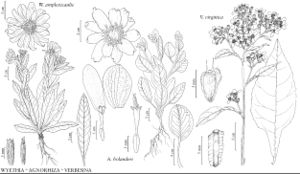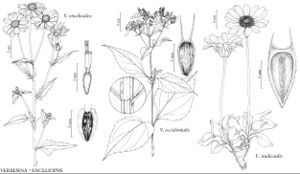Verbesina
Sp. Pl. 2: 901. 1753.
Gen. Pl. ed. 5, 384. 1754.
Annuals or perennials [shrubs, trees], 7–15+ cm (Verbesina nana) or 30–200 (–400) [–2500+] cm. Stems usually erect, usually branched (internodes sometimes winged). Leaves basal and/or cauline; opposite (sometimes whorled) or alternate; petiolate or sessile; blades (pinnately nerved or 3-nerved or 5-nerved from at or near bases) mostly rhombic, deltate, ovate, or elliptic to lanceolate or lance-linear (sometimes intermediate shapes), sometimes pinnately or palmately lobed, bases cuneate to rounded or cordate, ultimate margins subentire or toothed, faces glabrous or hairy. Heads radiate or discoid, borne singly or in corymbiform, dichasiiform, or paniculiform arrays. Involucres hemispheric, turbinate, or campanulate to saucerlike, 5–20+ [–30+] mm diam. Phyllaries persistent, 9–30 [–50+] in 1–4 [–5+] series (orbiculate, ovate, or oblong to spatulate, lanceolate, or linear, subequal or unequal, outer shorter or longer than inner, herbaceous to chartaceous). Receptacles flat to convex or ± conic, paleate (paleae usually navicular, ± conduplicate, herbaceous to scarious, linear to filiform in V. encelioides and V. nana). Ray-florets 0 or (1–) 5–30, either pistillate and fertile, or styliferous and sterile, or neuter; corollas yellow to orange or ochroleucous [reddish]. Disc-florets 8–150 [–300+], bisexual, fertile; corollas usually concolorous with rays, tubes much shorter than or ± equaling funnelform or campanulate throats, lobes 5, ± deltate to lance-deltate. Cypselae ± flattened, orbiculate, obovate, or oblanceolate to ± elliptic (usually winged); pappi persistent [falling], usually of 2, ± subulate scales or awns, sometimes 0. x = 17, 18?
Distribution
Mostly subtropical, tropical, and warm-temperate North America
Discussion
Species 200 or more (16 in the flora).
Selected References
Lower Taxa
Key
| 1 | Leaves all or mostly alternate (proximalmost sometimes opposite) | > 2 |
| 1 | Leaves all or mostly opposite (distal sometimes alternate) | > 7 |
| 2 | Corollas usually ochroleucous, sometimes white | > 3 |
| 2 | Corollas yellow | > 5 |
| 3 | Ray florets 0 | Verbesina walteri |
| 3 | Ray florets (1–)2–12+ | > 4 |
| 4 | Ray florets (1–)2–3(–7); disc florets 8–12(–15) | Verbesina virginica |
| 4 | Ray florets (9–)10–12+; disc florets 20–25+ | Verbesina microptera |
| 5 | Plants 10–50(–120+)cm (annuals); internodes not winged; disc florets 80–150+ | Verbesina encelioides |
| 5 | Plants 7–15 or 30–200+ cm (perennating bases ± erect or horizontal); internodes (at least proximal) winged; disc florets 40–80+ | > 6 |
| 6 | Heads (3–)8–25(–50+) in corymbiform to paniculiform arrays; phyllaries 8–12in 1(–2) series, ± spreading to reflexed; ray florets (2–)6–8+ | Verbesina alternifolia |
| 6 | Heads 2–5(–10+) in ± corymbiform arrays; phyllaries 16–21+ in 2–3 series,± erect; ray florets 8–13+ | Verbesina helianthoides |
| 7 | Internodes winged | > 8 |
| 7 | Internodes not winged | > 9 |
| 8 | Phyllaries 8–12+ in 2 series; ray florets (0–)1–3(–5); disc florets 8–15+; pappi 3–4 mm | Verbesina occidentalis |
| 8 | Phyllaries 18–20+ in 2–3 series; ray florets (5–)8; disc florets 20–60+; pappi 0–0.3mm | Verbesina heterophylla |
| 9 | Plants mostly 7–15+ cm; leaves: abaxial faces mostly strigoso-sericeous; cypselae± strigillose | Verbesina nana |
| 9 | Plants mostly 30–100(–150+) cm; leaves: faces (at least abaxial) scabrellous to hirtellous, hirsutulous, or hispidulous (not strigoso-sericeous); cypselae glabrous or sparsely hirtellous | > 10 |
| 10 | Perennating bases horizontal; disc florets 40–60(–80+); cypselae purplish black; Florida | > 11 |
| 10 | Perennating bases ± erect; disc florets 60–120+; cypselae dark brown; Arizona, California, New Mexico, Texas | > 12 |
| 11 | Phyllaries 2–3+ mm; ray florets (5–)11–13; cypselae 4–5 mm; pappi 0.5–1mm | Verbesina aristata |
| 11 | Phyllaries 5–9+ mm; ray florets 0; cypselae 5–7 mm; pappi 0–0.3 mm | Verbesina chapmanii |
| 12 | Leaf blades ± lance-linear (lengths 10–15 times widths) | Verbesina longifolia |
| 12 | Leaf blades lance-elliptic, lance-ovate, ovate, ovate-deltate, or rhombic (lengths mostly 1.5–2.5 times widths) | > 13 |
| 13 | Pappi 3–4 mm | Verbesina dissita |
| 13 | Pappi 0–0.5 mm | > 14 |
| 14 | Phyllaries 12–16 in ± 2 series, lance-linear, lance-ovate, or linear, 4–7 mm | Verbesina oreophila |
| 14 | Phyllaries 18–30+ in 3–4 series, elliptic, oblong, orbiculate, or ovate, 5–12+ mm | > 15 |
| 15 | Involucres 10–15+ mm diam.; phyllaries elliptic to oblong; cypselae 10 mm | Verbesina rothrockii |
| 15 | Involucres 15–22+ mm diam.; phyllaries oblong, orbiculate, or ovate; cypselae 7 mm | Verbesina lindheimeri |
"broader" is not a number.

